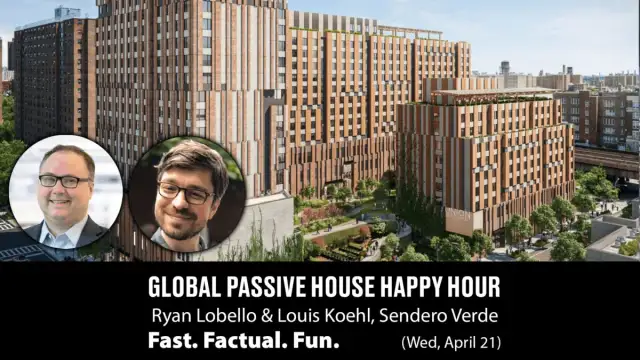Last week’s guests at Construction Tech were Aleksandr Yelizarov, Sherzod Ziyakhanov, and Cheyenne Xu of the New York City-based Monadnock Construction. In the video, the three talked about the technical, the technique, and the technology of multifamily construction, as well as the keys to Monadnock’s success, and paid special attention to a project that has been PHIUS pre-certified located at 425 Grand Concourse in the South Bronx. Though they focused on one building, Monadnock is currently responsible for more than 1.5 million square feet of Passive House projects that are completed, under construction, or in preconstruction. They have had buildings certified by both PHI and PHIUS, including The House at Cornell Tech.
425 Grand Concourse will be over 310,000 square feet when complete and contains a mix of field-installed panels and brick. As Aleksandr said during the presentation, maintaining a high level of craftsmanship, staying on schedule, and keeping a tight budget are always necessary for any construction company, but these all become more important when the firm is working on a Passive House project. “Contractors’ commitment from early construction phases is vital to the project’s success,” he added. This includes coordinating with the designers, the consultants, and everyone involved in the construction and determining how the team plans to erect the building, what materials will be used, and how QA and QC will be performed.
As Sherzod noted, building onsite mock-ups is integral to maintaining quality control and has become standard practice for Monadnock, since it allows tradespeople to work out the details and practice installation. A move novel form of QC comes during construction. As Aleksandr noted, it is standard procedure to installs metal clad around window installation before the sheet rock gets put in. This is not done to improve airtightness per se; rather, it's done to shield the insulation around the window from accidental damage.
One of the most impressive parts of the Grand Concourse project is its scheduling. This is largely due to the early decision to not use mega panels, had been done with Cornell Tech. Like any other prefabricated panel, mega panels are fabricated in a factory, and then shipped to the construction site. However, as Aleksandr explained, there is an inherent risk when using these kinds of panels because any delays in production or delivery means delays in the enclosure of the façade. That means no work can be done on the interior.
To avoid these issues, Monadnock decided to instead use field-install panels, which separated the panel installation from the interior sequences. Little did they know when they broke ground in early 2020, this decision would save them from months of COVID-related delays that would have ground construction to a standstill.
There were other advantages to using field install panels. As Cheyenne explained, they do not require a crane to install, there are far more suppliers when compared to suppliers of mega panels, and they still maintain continuous vapor barriers and insulation like mega panels. Furthermore, Monadnock was able to devise a sequencing schedule allowing interior work to start as soon as superstructure had been erected. As they moved up each floor, the trades were able to install the precast lentil from the inside, the window, and then start work on the interior buildout without having to wait for the panels to be installed. Using these kinds of panels, as opposed to mega panels, also meant that installation could begin before the building had even topped out.
To learn more about their amazing sequencing and this huge Passive House project, check out the presentation at the top of the page.



